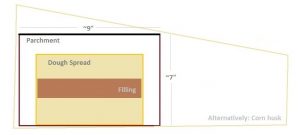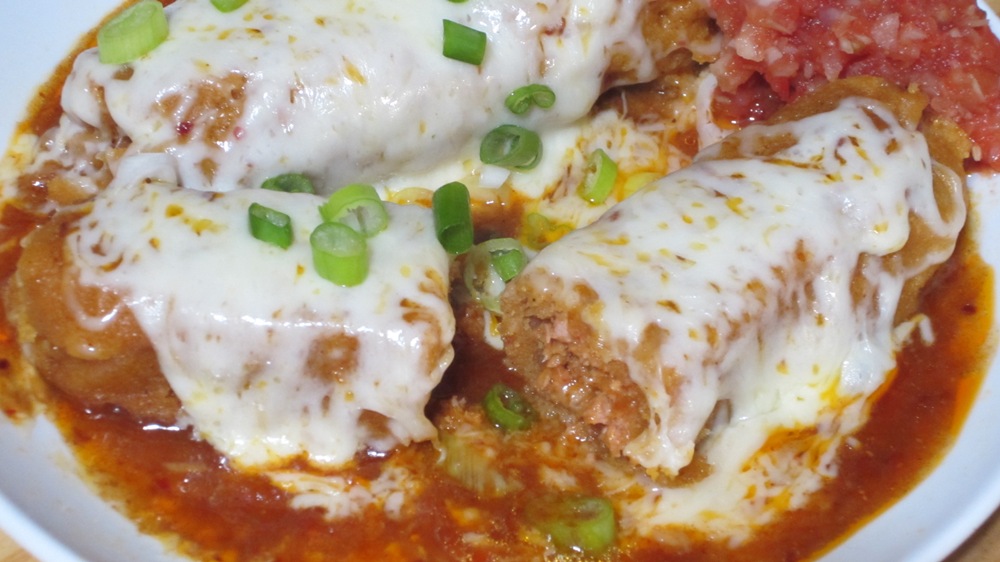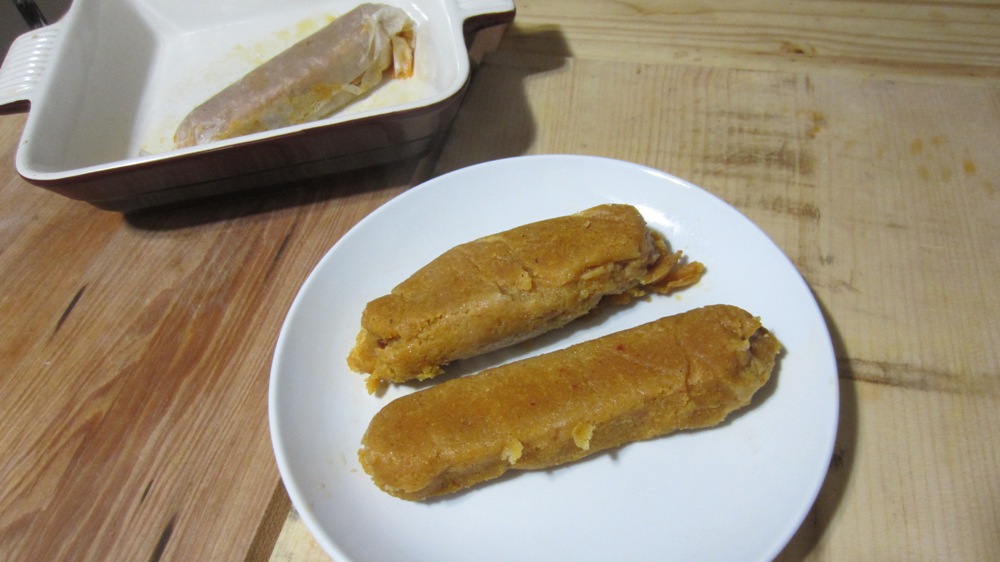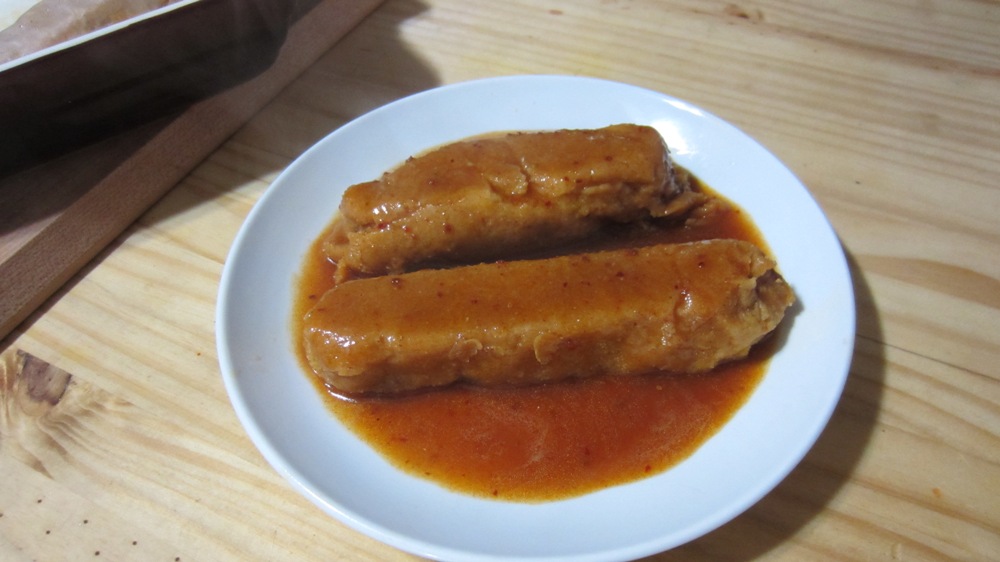With most fresh masa half a continent away these are not Mexican. They also aren’t truly the Mississippi ‘Delta Hot Tamale’ style developed for cotton field workers at the turn of the twentieth century by a curious mix of Italian and Mexican immigrants who had only ordinary corn meal available. Both styles are indeed delicious and pack a corn husk full of history in the bargain.
My different-yet-still-satisfying version here is inspired by the latter and are as close as I can get inside Canadian borders given our severely limited supply lines for the likes of dried chiles, corn husks, and masa para tamales. You have to work with what you have and it seems the French and Scottish settlers of the Maritimes didn’t bring any tamale culture with them when they landed a few hundred years ago. If you must know there haven’t been many decent tacos since either.
While a simple ground meat filling is traditional, countless other permutations are easily explored. Braised pork shoulder or shredded roast chicken can be used if some small attention is given to spicing and texture – it needs to fit inside steamed dough and be tender enough to eat with only a fork so it remains intact from first to last bite.
Vegetarians can substitute their shortening of choice in the dough with a bit of experimentation using locally available brands. Vegetarian-friendly fillings based on mushroom, spinach, or bean combinations are easily substituted here too although typically require pre-cooking to reduce moisture content as needed for good tamale structure. For example my own tests tell me you should plan on double the weight of mushrooms to get a comparable amount of filling but that opens more doors of wild mushroom opportunity I say. Gluten avoiders conveniently get a free ride with most tamales as well.
Fresh sweet corn in season or cactus (nopales) roasted over charcoal happily help fill any tamale with as little or as much chile enhancement as you care to add. Sweet versions can be stacked next to savoury. Most cheeses however should be reserved for finish topping rather than filling to help avoid collapse during steaming.
A tamalada is a tamale making party frequently held during the holidays with family and friends. What a good idea.
Yield: Roughly one dozen, six-inch tamales. For consistency, make multiple batches as needed rather than multiplying this recipe. Uncooked tamales can be frozen in a single layer before packing into bundles for later cooking within six months. Steam from frozen but cooking time to proper internal temperature will of course be longer. Do not microwave before or after initial cooking. Use steam instead to reheat if required.
For the dough:
400g corn meal, coarse preferred but most will work, any colour desired
2 tablespoons Mexican spice blend (see below)
2 tablespoons corn starch (aids binding)
1 tablespoon baking powder
2 teaspoons fine sea salt
1 tablespoons sugar (optional depending on filling used)
175g unsalted butter, freshly rendered lard, or a combination (avoid processed lard)
300ml cold water (conveniently equal to 300g)
Pulse dry ingredients in a food processor to combine well. Add butter/lard and pulse briefly to incorporate. Add water and process into a wet dough. Set aside 15 minutes before use. Reserve small portion for filling below.
For basic ground meat filling:
Note: Baking soda here helps prevent ground meat from ‘seizing’ into an overly dense texture when cooked. Particularly important if meat is not freshly ground.
2 tablespoons corn or neutral vegetable oil
1 medium onion, diced fine
50-100g fresh chiles, minced (optional, any variety to taste)
2 cloves fresh garlic, minced
2 teaspoons baking soda
500g ground beef, pork, or chicken – freshly ground preferred
2 tablespoons Mexican spice blend (see below)
100g reserved dough (from above)
Sauté onion and chiles in oil briefly over medium heat to soften, roughly four minutes. Add garlic and sauté until fragrant, about one minute longer. Allow to cool.
Dissolve baking soda with two tablespoons water in a large bowl. Add ground meat, spice blend, reserved dough, and cooled onion mixture. Combine well with hands and chill until ready to form tamales.
For the sauce:
2 tablespoons Mexican spice blend (see below)
1 tablespoon vegetable oil (corn preferred, avoid olive)
2 cups chicken or vegetable stock
1 – 2 teaspoons fine sea salt, adjusted according to stock used
1 tablespoon corn starch
Prepare the sauce just prior to serving by placing spices in a dry saucepan over medium heat. Toast until slightly fragrant, about two minutes. Add oil and continue to ‘bloom’ flavours over heat, roughly a minute longer. Add the stock and whisk well, tasting to adjust salt as needed. Dissolve the corn starch in 100ml cold water then whisk in to thicken over heat for a final minute. Serve over steamer-hot tamales immediately.
Forming & Steaming Tamales:
One dozen parchment papers (approximately 9 x 7 inches) or pre-soaked corn husks for assembly
Most importantly, USE A SCALE to portion equal weights of dough and filling. Typically 50 – 60g portions of each to make one average tamale but adjust as needed keeping dough and filling measures equal. Attempts to guess here nearly always use far too much dough in an effort to fully encase the filling resulting in dry, uninteresting tamales. Unbalanced is not the way to a happy tamalada.
Traditionally wrappers are dry corn husks that have been rehydrated by covering with very hot water for 15 minutes. Fresh green husks and banana leaves can also be used in season if available. Parchment paper cut to fit works perfectly well barring all other options and many prefer it for consistent assembly. Natural wrappers do impart some small flavour but the difference in blind taste tests is slight.
On your first few attempts it can helpful if you use a kitchen ruler to get your bearings. Scatter a measured portion of the loose dough to cover a rectangular space 6 inches x 4.5 inches adjacent to one edge of parchment or corn husk leaving empty space on one long side to wrap the assembled tamale (see diagram). Resist the temptation add ‘just a little more dough’ and stick to the premeasured amount. Press the dough to firm into a single cohesive layer once it covers the desired area. Roll a ‘log’ shape of filling six inches long and place in the centre of the dough rectangle. Roll the wrapper from the ‘dough edge’ so that the two longest edges of dough meet to completely encase the filling followed by any excess wrapper around the whole tamale.

Twist or fold the ends to seal and stack horizontally in a shallow ceramic dish that will fit inside your steam pot for ease of handling. Alternate the direction when stacking multiple layers to ensure good steam flow around all. Work in batches that fit your equipment but multiple dishes can usually be stacked as long as steam will adequately surround everything. Inexpensive yet enormous steamers are easily found in any Mexican or Chinese grocery. Make dim sum next week.
Place the dish with assembled tamales in a large steaming pot filled with several inches of water brought up to full temperature so that a lid can be placed without interference. Use a small saucer atop the last layer to hold the ‘tamale stack’ in place and protect them from excessive water accumulation/drips during cooking. Steam until an internal temperature of 95C (203F) is reached at the center of the tamales, usually between 30 and 45 minutes, being sure to check the water level periodically. If more water is needed add it from an already boiling kettle to minimize interference with the cooking process.
Serve with sauce (above) while still very hot. Cotija cheese, coriander leaf (cilantro), Mexican crema, or sombrero toppings optional.
Mexican Spice Blend
While making a batch for the tamales above, mix extra to use for tacos, fajitas, bean dip, etc. I mix without salt to allow recipe specific adjustments. Use whatever dried chiles are available in your area knowing more varieties sum up to more interesting results but even a few of the most basic (widely available) sorts will still work well. The inclusion of mustard seed gives the mix some small power to emulsify as much as the hint of flavour which I’ve found very helpful for many of the dishes in which it lands.
Mix by volume and grind in a small coffee mill just before use. A large air-tight storage jar is convenient for shake-mixing prior to measuring needed amounts.
5 parts sweet paprika (optionally substitute one part with smoked paprika)
2 parts sweet dried chile flakes/pieces, e.g. Ancho, guajillo, New Mexican red
1 part hot dried chile flakes/pieces, e.g. arbol or Indian/Chinese red
1 part whole cumin seed
1 part whole black peppercorn
1 part Mexican oregano
1/2 part garlic granules
1/4 part whole mustard seed, yellow or brown
1/4 part super hot dried chile flakes/pieces. e.g. habanero, Thai (optional)
scant part ground cinnamon (very very optional)




